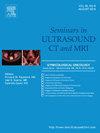Pathologic Findings of Pulmonary Lymphoproliferative Disorders
IF 1.9
4区 医学
Q3 RADIOLOGY, NUCLEAR MEDICINE & MEDICAL IMAGING
引用次数: 0
Abstract
Pulmonary lymphoproliferative disorders (PLDs) are a diverse group of rare entities characterized by abnormal lymphoid proliferation within the lung. These include both benign and malignant processes and are classified into five categories in the 2021 WHO Classification of Thoracic Tumors: benign hyperplastic disorders, primary pulmonary neoplasms, secondary involvement of the lung, posttransplant lymphoproliferative disorders, and histiocytic neoplasms. Diagnosing PLDs is often challenging due to their histological similarity to other lymphocyte-rich interstitial lung diseases, including cellular nonspecific interstitial pneumonia (NSIP) and hypersensitivity pneumonitis. A multidisciplinary approach integrating clinical, radiologic, and pathological information is essential to reach an accurate diagnosis. This review focuses on the detailed pathological features of PLDs, particularly benign hyperplastic disorders and primary pulmonary neoplasms. It emphasizes the differential diagnosis and highlights distinguishing characteristics among key subtypes, including lymphoid interstitial pneumonia, follicular bronchiolitis, nodular lymphoid hyperplasia, Castleman disease, IgG4-related disease, and primary pulmonary lymphomas such as MALT lymphoma, diffuse large B-cell lymphoma, and lymphomatoid granulomatosis. Special attention is paid to morphological patterns, immunophenotypes, and diagnostic challenges encountered with small biopsies. Given the broad differential diagnosis and potential overlap with infectious, autoimmune, or immunodeficiency-related conditions, careful clinicopathological correlation remains the cornerstone of accurate classification and appropriate management. This review aims to enhance diagnostic clarity and support effective interdisciplinary evaluation of suspected PLD cases.
肺淋巴细胞增生性疾病的病理表现。
肺淋巴细胞增生性疾病(PLDs)是一种以肺内异常淋巴细胞增生为特征的罕见疾病。这些肿瘤包括良性和恶性病变,并在2021年世卫组织胸部肿瘤分类中分为五类:良性增生性疾病、原发性肺肿瘤、继发性肺受累、移植后淋巴增生性疾病和组织细胞肿瘤。由于PLDs与其他淋巴细胞丰富的间质性肺疾病(包括细胞性非特异性间质性肺炎(NSIP)和超敏性肺炎)的组织学相似,诊断PLDs通常具有挑战性。综合临床、放射学和病理信息的多学科方法对于准确诊断至关重要。本文综述了PLDs的详细病理特征,特别是良性增生性疾病和原发性肺肿瘤。它强调鉴别诊断,强调关键亚型的区别特征,包括淋巴样间质性肺炎、滤泡性细支气管炎、结节性淋巴样增生、Castleman病、igg4相关疾病,以及原发性肺淋巴瘤如MALT淋巴瘤、弥漫性大b细胞淋巴瘤和淋巴瘤样肉芽肿病。特别注意形态学模式,免疫表型和诊断挑战遇到的小活检。鉴于广泛的鉴别诊断和与感染性、自身免疫或免疫缺陷相关疾病的潜在重叠,仔细的临床病理相关性仍然是准确分类和适当治疗的基石。本综述旨在提高诊断清晰度,并支持对疑似PLD病例进行有效的跨学科评估。
本文章由计算机程序翻译,如有差异,请以英文原文为准。
求助全文
约1分钟内获得全文
求助全文
来源期刊
CiteScore
2.60
自引率
0.00%
发文量
49
审稿时长
6-12 weeks
期刊介绍:
Seminars in Ultrasound, CT and MRI is directed to all physicians involved in the performance and interpretation of ultrasound, computed tomography, and magnetic resonance imaging procedures. It is a timely source for the publication of new concepts and research findings directly applicable to day-to-day clinical practice. The articles describe the performance of various procedures together with the authors'' approach to problems of interpretation.

 求助内容:
求助内容: 应助结果提醒方式:
应助结果提醒方式:


